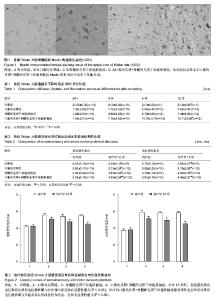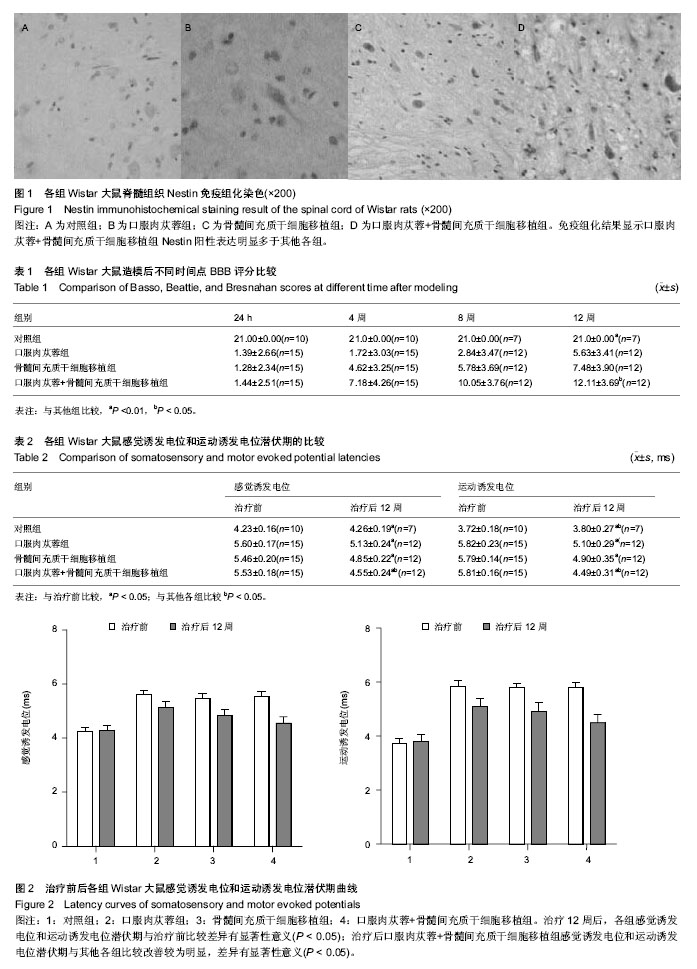Chinese Journal of Tissue Engineering Research ›› 2014, Vol. 18 ›› Issue (41): 6639-6644.doi: 10.3969/j.issn.2095-4344.2014.41.014
Previous Articles Next Articles
Cistanche deserticola plus bone marrow mesenchymal stem cell transplantation for treating spinal cord injury in rats
Lan Jing, Yan Jin-yu, Xia Run-fu, Li Jian-feng
- Rehabilitation Department, the Second Affiliated Hospital of Inner Mongolia Medical University, Hohhot 010030, Inner Mongolia Autonomous Region, China
-
Revised:2014-09-11Online:2014-10-01Published:2014-10-01 -
Contact:Li Jian-feng, M.D., Attending physician, Rehabilitation Department, the Second Affiliated Hospital of Inner Mongolia Medical University, Hohhot 010030, Inner Mongolia Autonomous Region, China -
About author:Lan Jing, Nurse in charge, Rehabilitation Department, the Second Affiliated Hospital of Inner Mongolia Medical University, Hohhot 010030, Inner Mongolia Autonomous Region, China
CLC Number:
Cite this article
Lan Jing, Yan Jin-yu, Xia Run-fu, Li Jian-feng. Cistanche deserticola plus bone marrow mesenchymal stem cell transplantation for treating spinal cord injury in rats[J]. Chinese Journal of Tissue Engineering Research, 2014, 18(41): 6639-6644.
share this article

2.1 实验动物数量分析 55只脊髓损伤模型Wistar大鼠均进入结果分析,中途无脱落。 2.2 免疫组化检测结果 骨髓间充质干细胞移植组和口服肉苁蓉+骨髓间充质干细胞移植组的脊髓损伤部位以及相邻的组织内均有Nestin阳性细胞(图1),且口服肉苁蓉+骨髓间充质干细胞移植组阳性表达明显较骨髓间充质干细胞移植组多。对照组、口服肉苁蓉组无Nestin阳性细胞表达。 2.3 BBB评分结果 BBB评分结果显示,治疗24 h、4周和8周各组评分差异无显著性意义(P > 0.05)。12周时各组与对照组比较差异有显著性意义(P < 0.01),口服肉苁蓉+骨髓间充质干细胞移植组与其他各组比较差异有显著性意义(P < 0.05,表1)。 2.4 电生理测定结果 口服肉苁蓉组和口服肉苁蓉+骨髓间充质干细胞移植组各有1只大鼠感觉诱发电位和运动诱发电位均检测不到。治疗12周后,各实验组感觉诱发电位和运动诱发电位潜伏期与治疗前比较差异有显著性意义(P < 0.05);治疗后口服肉苁蓉+骨髓间充质干细胞移植组感觉诱发电位潜伏期与其他各组比较改善较为明显,差异有显著性意义(P < 0.05),治疗后口服肉苁蓉+骨髓间充质干细胞移植组运动诱发电位潜伏期与其他各组比较差异也有显著性意义(P < 0.05),见表2,图2。"

| [1] Zeddou M, Relic B, Malaise MG.Umbilical cord fibroblasts: Could they be considered as mesenchymal stem cells.World J Stem Cells. 2014;6(3):367-370. [2] Tuli R, Tuli S, Nandi S,et al.Characterization of multipotential mesenchymal progenitor cells derived from human trabecular bone.Stem Cells. 2003;21(6):681-693. [3] Fukumoto T, Sperling JW, Sanyal A,et al.Combined effects of insulin-like growth factor-1 and transforming growth factor-beta1 on periosteal mesenchymal cells during chondrogenesis in vitro.Osteoarthritis Cartilage. 2003;11(1): 55-64. [4] Wickham MQ, Erickson GR, Gimble JM, et al.Multipotent stromal cells derived from the infrapatellar fat pad of the knee.Clin Orthop Relat Res. 200;(412):196-212. [5] Jankowski RJ, Deasy BM, Huard J.Muscle-derived stem cells.Gene Ther. 2002;9(10):642-647. [6] Bakopoulou A, Leyhausen G, Volk J,et al.Comparative analysis of in vitro osteo/odontogenic differentiation potential of human dental pulp stem cells (DPSCs) and stem cells from the apical papilla (SCAP).Arch Oral Biol. 2011;56(7):709-721. [7] Parker AM, Katz AJ.Adipose-derived stem cells for the regeneration of damaged tissues.Expert Opin Biol Ther. 2006; 6(6):567-578. [8] Urdzíková LM, R??i?ka J, LaBagnara M, et al.Human mesenchymal stem cells modulate inflammatory cytokines after spinal cord injury in rat.Int J Mol Sci. 2014;15(7): 11275-11293. [9] Urdzíková L, Jendelová P, Glogarová K,et al.Transplantation of bone marrow stem cells as well as mobilization by granulocyte-colony stimulating factor promotes recovery after spinal cord injury in rats.J Neurotrauma. 2006;23(9): 1379-1391. [10] Coutts M, Keirstead HS.Stem cells for the treatment of spinal cord injury.Exp Neurol. 2008;209(2):368-377. [11] Garbuzova-Davis S, Willing AE, Saporta S,et al.Novel cell therapy approaches for brain repair.Prog Brain Res. 2006; 157:207-222. [12] Joyce N, Annett G, Wirthlin L,et al.Mesenchymal stem cells for the treatment of neurodegenerative disease.Regen Med. 2010;5(6):933-946. [13] Hardy SA, Maltman DJ, Przyborski SA.Mesenchymal stem cells as mediators of neural differentiation.Curr Stem Cell Res Ther. 2008;3(1):43-52. [14] Nishio Y, Koda M, Kamada T,et al.The use of hemopoietic stem cells derived from human umbilical cord blood to promote restoration of spinal cord tissue and recovery of hindlimb function in adult rats.J Neurosurg Spine. 2006;5(5): 424-433. [15] Zhang C,He XJ,Li HP,et al. Chondroitinase ABC plus bone marrow mesenchymal stem cells for repair of spinal cord injury. Neural Regen Res. 2013; 8(11): 965-974. [16] Iwashita Y, Kawaguchi S, Murata M.Restoration of function by replacement of spinal cord segments in the rat.Nature. 1994; 367(6459):167-170. [17] Li Y, Field PM, Raisman G.Repair of adult rat corticospinal tract by transplants of olfactory ensheathing cells.Science. 1997;277(5334):2000-2002. [18] Martin D, Robe P, Franzen R,et al.Effects of Schwann cell transplantation in a contusion model of rat spinal cord injury.J Neurosci Res. 1996;45(5):588-597. [19] Ohta M, Suzuki Y, Noda T,et al.Bone marrow stromal cells infused into the cerebrospinal fluid promote functional recovery of the injured rat spinal cord with reduced cavity formation.Exp Neurol. 2004;187(2):266-278. [20] Lee H, Kang JE, Lee JK,et al.Bone-marrow-derived mesenchymal stem cells promote proliferation and neuronal differentiation of Niemann-Pick type C mouse neural stem cells by upregulation and secretion of CCL2.Hum Gene Ther. 2013;24(7):655-669. [21] Park DY, Mayle RE, Smith RL,et al.Combined Transplantation of Human Neuronal and Mesenchymal Stem Cells following Spinal Cord Injury.Global Spine J. 2013;3(1):1-6. [22] Cuevas P, Carceller F, Dujovny M, et al.Peripheral nerve regeneration by bone marrow stromal cells.Neurol Res. 2002; 24(7):634-638. [23] Lee J, Kuroda S, Shichinohe H,et al.Migration and differentiation of nuclear fluorescence-labeled bone marrow stromal cells after transplantation into cerebral infarct and spinal cord injury in mice.Neuropathology. 2003;23(3): 169-180. [24] Mezey E, Chandross KJ, Harta G,et al.Turning blood into brain: cells bearing neuronal antigens generated in vivo from bone marrow.Science. 2000;290(5497):1779-1782. [25] 顾加祥,尚修超,刘宏君, 等. GDNF基因诱导骨髓间充质干细胞向神经细胞分化的实验研究[J].中国实验诊断学,2014,18(3): 354-357. [26] 黄建锋,黄继锋,张伟才. 两种细胞因子联合诱导骨髓间充质干细胞向神经样细胞分化[J].中国组织工程研究,2014,18(6): 829-834. [27] 李娟,吴建军,刘凯,等. 肉苁蓉含药血清对BMSC分化为神经细胞的诱导作用研究[J].中国中医药科技,2013,20(5):486-487, 570. [28] 徐丽丽,匡弢,张佳. 体外诱导骨髓间充质干细胞向神经元样细胞分化:两种方法的比较[J].中国组织工程研究,2013,17(45): 7821-7826. [29] 陈增生,褚强,刘艳凤,等. 诱导剂共培养:谁更适宜骨髓间充质干细胞向神经细胞的分化[J].中国组织工程研究,2013,17(32): 5757-5764. [30] 何丁文,殷嫦嫦,殷明,等.不同血清浓度对bFGF联合EGF诱导BMSCs向神经细胞分化的影响[J].神经解剖学杂志,2013,29(1): 18-24. [31] 孙惠敏,刘婷,马丽君,等.人骨髓干细胞分离及其向神经细胞诱导分化的实验研究[J].宁夏医科大学学报,2013,35(5):502-505. [32] 杜晓鸣,魏会平,张爱兰,等.川芎嗪对大鼠骨髓间充质干细胞长期诱导效应的研究[J].中国中医药现代远程教育,2012,10(13): 157-158. [33] 杜红阳,付海燕,包翠芬,等.地黄多糖对大鼠骨髓间充质干细胞向神经样细胞诱导分化作用的研究[J].中国实验方剂学杂志, 2012,18(6):133-137. [34] 陈再丰,许信龙,魏晓捷,等.鼠神经生长因子诱导骨髓间充质干细胞向神经元样细胞分化的实验研究[J].中国临床药理学与治疗学,2012,17(2):137-140. [35] Quertainmont R, Cantinieaux D, Botman O,et al. Mesenchymal stem cell graft improves recovery after spinal cord injury in adult rats through neurotrophic and pro-angiogenic actions.PLoS One. 2012;7(6):e39500. [36] Boido M, Garbossa D, Fontanella M,et al.Mesenchymal stem cell transplantation reduces glial cyst and improves functional outcome after spinal cord compression.World Neurosurg. 2014;81(1):183-190. [37] Karaoz E, Kabatas S, Duruksu G,et al.Reduction of lesion in injured rat spinal cord and partial functional recovery of motility after bone marrow derived mesenchymal stem cell transplantation.Turk Neurosurg. 2012;22(2):207-217. [38] Nakajima H, Uchida K, Guerrero AR,et al.Transplantation of mesenchymal stem cells promotes an alternative pathway of macrophage activation and functional recovery after spinal cord injury.J Neurotrauma. 2012;29(8):1614-1625. [39] Uccelli A, Benvenuto F, Laroni A, et al.Neuroprotective features of mesenchymal stem cells.Best Pract Res Clin Haematol. 2011;24(1):59-64. [40] Osaka M, Honmou O, Murakami T,et al.Intravenous administration of mesenchymal stem cells derived from bone marrow after contusive spinal cord injury improves functional outcome.Brain Res. 2010;1343:226-235. [41] 白清云.中国医学百科全书•蒙医学[M].上海:上海科学技术出版社,1992:188. [42] Tian XF, Pu XP.Phenylethanoid glycosides from Cistanches salsa inhibit apoptosis induced by 1-methyl-4- phenylpyridinium ion in neurons.J Ethnopharmacol. 2005; 97(1):59-63. [43] Geng X, Song L, Pu X,et al.Neuroprotective effects of phenylethanoid glycosides from Cistanches salsa against 1-methyl-4-phenyl-1,2,3,6-tetrahydropyridine (MPTP)-induced dopaminergic toxicity in C57 mice.Biol Pharm Bull. 2004;27(6):797-801. [44] 王晓雯,孟新珍,蒋晓燕,等.肉苁蓉总苷对清醒小鼠脑缺血再灌注致海马CA1区脑组织损伤的保护作用[J].卒中与神经疾病,2003, 10(6): 325-328. [45] 罗兰,阿尔孜古丽•吐尔逊,王晓雯. 肉苁蓉总苷对β淀粉样蛋白25-35诱导PC12细胞凋亡的保护作用[J]. 中国新药与临床杂志. 2010, 29(2): 115-118. [46] Nakajima H, Uchida K, Guerrero AR,et al.Transplantation of mesenchymal stem cells promotes an alternative pathway of macrophage activation and functional recovery after spinal cord injury.J Neurotrauma. 2012;29(8):1614-1625. [47] Osaka M, Honmou O, Murakami T,et al.Intravenous administration of mesenchymal stem cells derived from bone marrow after contusive spinal cord injury improves functional outcome.Brain Res. 2010;1343:226-235. [48] Mohammadian M, Shamsasenjan K, Lotfi Nezhad P,et al.Mesenchymal stem cells: new aspect in cell-based regenerative therapy.Adv Pharm Bull. 2013;3(2):433-437. [49] Cantinieaux D, Quertainmont R, Blacher S,et al.Conditioned medium from bone marrow-derived mesenchymal stem cells improves recovery after spinal cord injury in rats: an original strategy to avoid cell transplantation.PLoS One. 2013;8(8): e69515. [50] Quertainmont R, Cantinieaux D, Botman O,et al. Mesenchymal stem cell graft improves recovery after spinal cord injury in adult rats through neurotrophic and pro-angiogenic actions.PLoS One. 2012;7(6):e39500. [51] Chen L, Cui X, Wu Z,et al.Transplantation of bone marrow mesenchymal stem cells pretreated with valproic acid in rats with an acute spinal cord injury.Biosci Trends. 2014;8(2): 111-119. |
| [1] | Wang Jian-ji, Yang Long, Li Jing, Sun Qi, Zuo Wei-min, Ren Qi-feng, Sun Yu, Wu Zhan-yu, Zou Qiang, Ma Min-xian, Ye Chuan. Development and application of special-purpose grafter by femoral head decompression combined with bone marrow mesenchymal stem cells transplantation based on three-dimensional printing technology [J]. Chinese Journal of Tissue Engineering Research, 2016, 20(44): 6636-6642. |
| [2] | Yu Yu-qin, Hu Nian-chun, Duan Ji-an, Li Da-peng, Liu Chang. Neuroprotective effects of sufentanil preconditioning on spinal cord injury in mouse models [J]. Chinese Journal of Tissue Engineering Research, 2016, 20(40): 5966-5972. |
| [3] | Fan Xu-hui, Yang Bo, Hu Xiang, Guan Fang-xia. Reactive hyperplasia of glial cells induced by spinal cord injury in a rat model [J]. Chinese Journal of Tissue Engineering Research, 2016, 20(40): 6001-6006. |
| [4] | Zhou Chang-yan, Zhou Qing-huan, Bian Jing, Chen Ke, Chen Wen. Bone marrow mesenchymal stem cells combined with calcium phosphate cement to repair articular cartilage defects in rabbits [J]. Chinese Journal of Tissue Engineering Research, 2015, 19(8): 1195-1199. |
| [5] | Wang Guo-xi, Wang Guo-qian, Zhang Shu-quan. Hyperbaric oxygen combined with Schwann cells transplantation for spinal cord injury in rats: electrophysiological and functional changes of the hind limbs [J]. Chinese Journal of Tissue Engineering Research, 2015, 19(14): 2205-2210. |
| [6] | Zhao Xiao-jian, Lu Cai-ping, Chu Wei-wei, Zhang Ya-xiao, Zhang Bing, Zhen Qiang, Tan Guo-liang, Wang Ren-feng, Liu Jia-bao, Wu Lin. Bone marrow mesenchymal stem cell transplantation for treatment of emphysema: intravenous versus intratracheal approach [J]. Chinese Journal of Tissue Engineering Research, 2015, 19(14): 2211-2215. |
| [7] | Liang Jian-ji, He Zhi-yong, Liu Kang, Li Xiao-ling, Cheng Wei-min, Yu Xin-ping, Chen Er-dong. Intraarticular injection of autologous bone marrow mesenchymal stem cells for mild-to-moderate osteoarthritis [J]. Chinese Journal of Tissue Engineering Research, 2015, 19(14): 2216-2223. |
| [8] | Gao Zhuo-yue, Liu Yong-qi, He Jian-xin, Wu Zhi-wei, Luo Ya-li, Su Yun, Zhang Li-ying, Zhang Qi, Wu You-ming, Zhou Ni-na. Regulatory effects of warming yang and invigorating qi treatment on the inflammatory balance and genetic stability of bone marrow mesenchymal stem cells under tumor microenvironment [J]. Chinese Journal of Tissue Engineering Research, 2015, 19(14): 2267-2272. |
| [9] | Jing Cai-xia, Liu Chang-kui, Tan Xin-ying, Luo Jin-chao, Hu Min. Bone mesenchymal stem cells with allogeneic bone to repair canine mandibular defects: detection of osteogenic ability [J]. Chinese Journal of Tissue Engineering Research, 2015, 19(14): 2138-2143. |
| [10] | Xu Xiang, Yin He-ping. Platelet-rich plasma accelerates the proliferation of bone marrow mesenchymal stem cells [J]. Chinese Journal of Tissue Engineering Research, 2015, 19(14): 2144-2148. |
| [11] | Su Xue-lian, Bao Guang-jie, Kang Hong, Liu Lin, Kong Nan-nan. Morphological changes of goat bone marrow mesenchymal stem cells differentiating into fibrochondrocytes [J]. Chinese Journal of Tissue Engineering Research, 2014, 18(6): 860-865. |
| [12] | Nie De-zhi, Wan Ying, Ben Liang, Wang Ying-jun, Liu Xiang-zhu, Wang Li-hui, Li Chao, Zhang Shi-dong. Stem cell tumorigenicity in Balb/c nude mice [J]. Chinese Journal of Tissue Engineering Research, 2014, 18(6): 888-893. |
| [13] | Fan Yan, Wang Jian-jun, Wei Feng, Fan Xiao-hai, Ma Ai-qun. Effect of adipose-derived mesenchymal stem cell transplantation on inflammatory response and ventricular remodeling after myocardial infarction [J]. Chinese Journal of Tissue Engineering Research, 2014, 18(6): 900-905. |
| [14] | Zhao Xiao-jian, Lu Cai-ping, Chu Wei-wei, Zhen Qiang, Tan Guo-liang, Zhang Ya-xiao, Wang Ren-feng, Zhang Bing, Liu Jia-bao. Bone marrow mesenchymal stem cell transplantation suppresses emphysema-induced inflammation and apoptosis [J]. Chinese Journal of Tissue Engineering Research, 2014, 18(6): 906-911. |
| [15] | Yuan Shu-fang, Hu Lan-ying, Jiang Tao, Sun Li-hua, Zheng Rong-jiong, Zhao Jin-yan, Zhang Yue-xin . Effect of bone marrow mesenchymal stem cells transplantation on the expression of CD163 and interleukin-10 in rats with acute hepatic liver failure [J]. Chinese Journal of Tissue Engineering Research, 2014, 18(6): 919-925. |
| Viewed | ||||||
|
Full text |
|
|||||
|
Abstract |
|
|||||